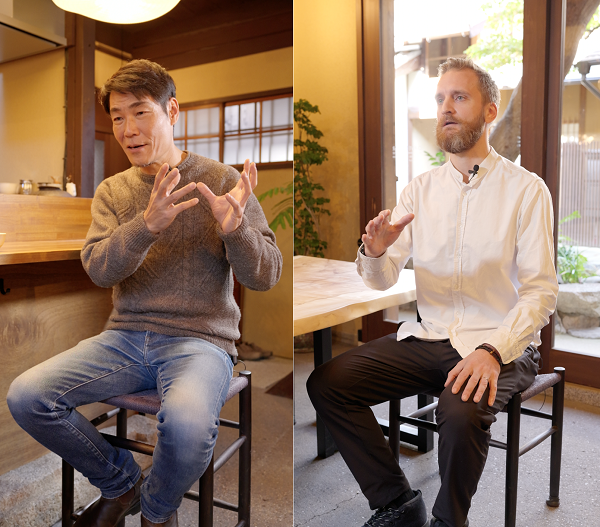
“Momiji-no-komichi”, alleys lined by Kyo-machiya townhouse, is located at Ishifudo-no-cho, Ukyo-ku, Kyoto-city. After going through a small path from a street, one will find a space encircled with Kyo-machiya, a quite different scenery from that of the outside. We have interviewed Mr. Drew Kent Wallin and Mr. Kei Tamura about the reasons and the thoughts on utilizing Kyo-machiya:Mr. Drew Kent who is a manager of “Momiji-no-komichi” running “Garden Lab“, and Mr. Kei Tamura who entrusts “Garden Lab” with the management of “05 Kyoto Rare Tea Bar” which serves a variety of tea.
Profile of Kyo-machiya
“Momiji-no-komichi”consists of the nine (9) renovated Kyo-machiya each of which is with over a century history. In its courtyard there is a magnifiscent maple (momiji) tree which is the origin of the place name. It is a complex-facility premise of multiple Kyo-machiya including “Garden Lab”, “05 Kyoto Rare Tea Bar”, a coffee shop, restaurants, an registered architect office, etc.
Drew Kent Wallin
Born in Canada. Manager of Momiji-no-komichi. Representative Director of Garden Lab Co., Ltd, which manages a co-working space & event/accommodation facility, and “05 Kyoto Rare Tea Bar.” When he was a university student, he was admitted into the graduate school of Kyoto University, where he made a research on “Kyo-machiya and its garden.”
>Garden Lab/O5 Kyoto Rare Tea Bar(move to the outside web site)
Kei Tamura
CEO of Tabikyo Japan Co., Ltd. Representative Director of 05 Tea Japan. While working as the representative of Tabikyo Japan Co., Ltd. which re-edits regional problems from the perspective of international standards and disseminates the related information, he works as the representative of the 05 Tea Japan, the Japanese entity of the brand, “Tea Bar” (a tea wholesaler) located in Vancouver, Canada.
>TABIKYO JAPAN.(move to the outside web site)
Wishing to be a bridge to let the charms of Japan known to the world
Mr. Tamura is active in various ways all over Japan to be a bridge between Japan and the world focusing on disseminating the Japanese cultural attractiveness as well as her unique provincial culture of specific regions from the viewpoint of the world.
He told that he had realized there were many occasions where Japanese charms were not well understood or just misunderstood while he had worked in many foreign countries for a long time.
Mr. Tamura said, “It is natural that non-Japanese does not know or understand Japan at all. This could be improved by providing an information source. If one visits Japan and sees and experiences Japanese real politeness, he/she could realize a Japanese unique charm. Among various Japanese attractiveness, we need to specially protect delicacies and scrupulousness of Japanese craftsman’s work.”
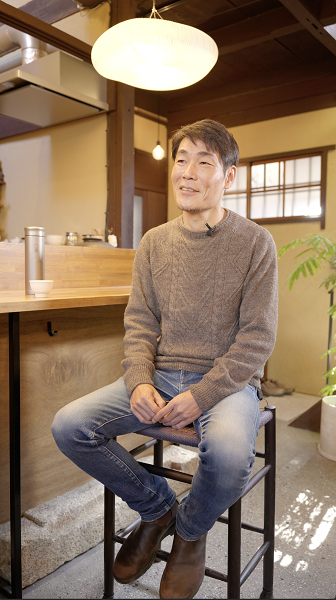
|
Exotic charm out from ”Kyo-machiya plus Tea”
Mr. Tamura had various occasions to familialize himself with tea while he had been engaged in various regional projects all over Japan, one of the major agricultural countries in the world. At the wholesaler,”O5 Rare Tea Bar” in Vancouver, Canada, many of its customers are the fans of tea, and they not only enjoy tea but also are interested in the Orient. Realizing that the number of people who are fascinated by tea is increasing, Mr. Tamura , in order to support the tea industry of Japan by building the same system of “O5 Rare Tea Bar”in Japan, introduced Mr. Wallin to Mr. Pedro Villalon, the Representative of “O5 Rare Tea Bar,”and its concept in the end of 2022. He then proposed “05 Kyoto Rare Tea Bar”to be operated at “Garden Lab”(with “Garden Lab” as the main operator). It was the best timing for Mr. Wallin who had been just reviewing the purposes of his space for interaction and Mr. Tamura who had been looking for a place for the tea business. Mr. Tamura never thought that any type of place was OK for the tea business, and explained the reason why he proposed Mr. Wallin to run the “Tea Bar” at his Kyo-Machiya as follows:.
“The atmosphere of the area, “Momiji-no-komichi” of Kyo-machiya maintained and managed by Mr. Wallin, nicely reflects craftsman’s fastidiousness, his own scrupulousness as well as his profound love and understanding of Kyo-machiya, which evidenced that personality-wise Mr. Wallin could be more Japanese than me, a pure Japanese. The combination of “Culture of Kyoto” and “Tea”is very exotic for those non-Japanese visiting Japan. I was quite sure that those visiting this space will surely enjoy tea and will go back to their own countries with the experienced and learned attractiveness of Kyo-machiya.”
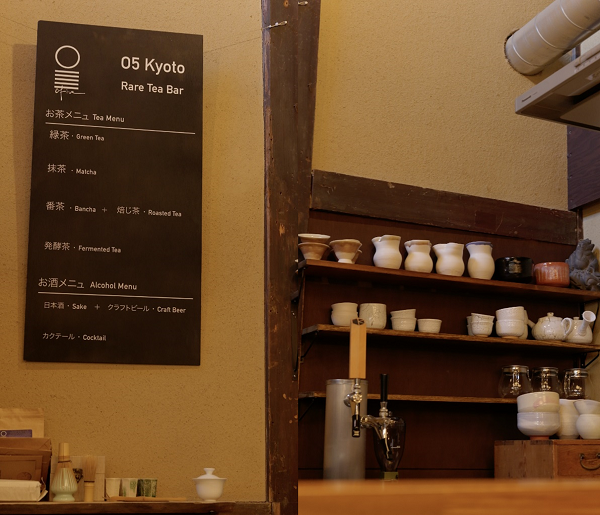
|
Kyo-machiya as a platform to experience Japanese culture
For Mr. Tamura there are some impressive words given by the visitors. It is not the occasional comment, “the tea served here was delicious”, but are “it was a good experience” and “I have learned a lot.” With such comments, he strongly realizes that for non-Japanese Kyo-machiya is “a platform to experience Japanese culture.” Since Mr. Tamura is actively disseinating Japanese charms to the world, he really appreciates such words from the customers, which could reassure himself on his work.
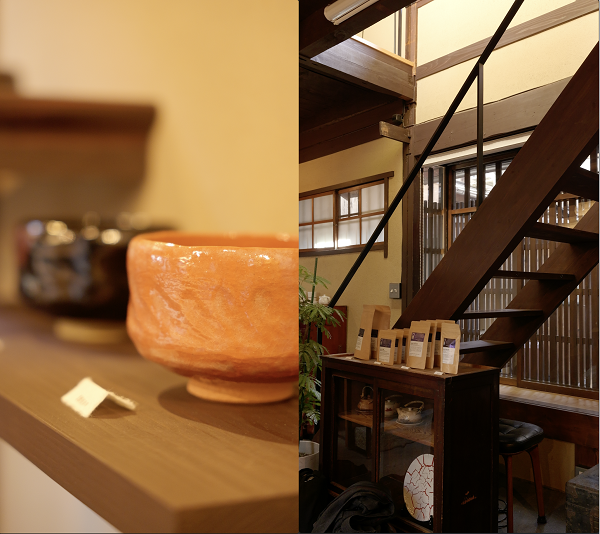
|
Feel “I am in kyoto”
Currently a great number of people are visiting Kyoto from all over the world. Mr. Tamura analyzes its reason as those visitors desire to experience Kyoto culture including Kyo-machiya, that is to say, to feel “I am in Kyoto.”
Mr. Tamura says, “I really wish that the Japanese also once again could re-discover the fascination and attractiveness of Japan and Kyoto which people in the entire world are closely watching.” This is the final target for Mr. Tamura who is actively disseminating the fascinations and charms of Japan to the world everyday.
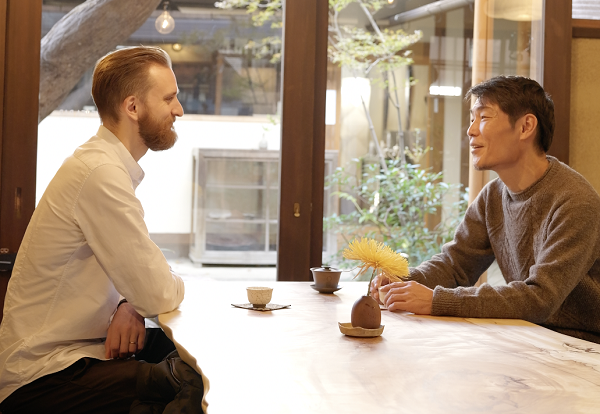
|
Making Kyo-machiya an attractive space for the international interaction
Mr. Wallin, who is managing “Momiji-no-komichi”, is also operating “Garden Lab,”a co-working space as well as an event/accommodation facility. This “Garden Lab” was established wth a purpose that many visitors from inside or outside of Japan may interact in an ideal space of Kyo-machiya.
Mr. Wallin who is from Canada did research on Kyo-machiya at the graduate school of Kyoto University. Then he was fascinated by “ambiguious borders”of Kyo-machiya. Mr. Wallin says,“In Canada, most houses are constructed with very thick walls, and the border between inside and outside is obvious. On the other hand, as for Kyo-machiya, there is Noren (a Japanese short curtain hung outside) which sometimes functions as a wall and a space of Doma (earthen floor) whose space could be considered as inside as well as outside with other variety of spaces such as Engawa (outside corridor), Tori-niwa (passage garden), Okuniwa (back garden) and Tsuboniwa (courtyeard). Having desired “to work” and “to live”in such an environment, he first established a company, the predecessor of “Garden Lab,”and he gradually wished to let more people enjoy this-type of cultural experiences.
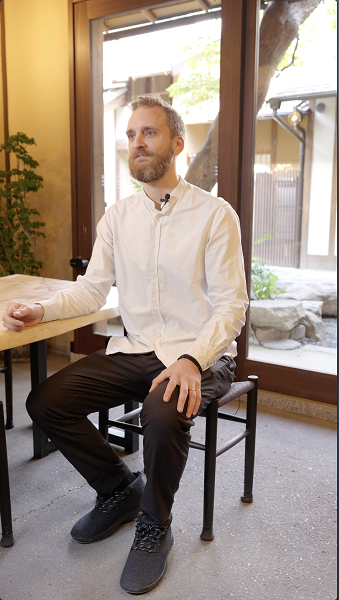
|
Encounter with Momiji-no-komichi
During the period of the predesessor company of “Garden Lab,” Mr. Wallin was told by the owner of the Kyo-machiya rent as his residence and office that the owner would renovate the Kyo-machiya (the current Momiji-no-komichi) which had been vacant for about 40 years. Mr. Wallin, then a research student of the graduate school, made efforts to cooperate with the owner by introducing a gardenor, attending planning meetings and by trying whatever he could do. In his cooperation he realized that a manager was needed if a community of Kyo-machiya share a garden as in the case of Momiji-no-komichi, and he raised his hand to accept such responsibility as the manager for “Momiji-no-komichi.” Mr. Wallin says, “I thought it might be ideal if I could work as a manger while I provide opportunities for various people to work at Kyo-machiya utilizing Kyo-machiya of Momiji-no-komichi.”
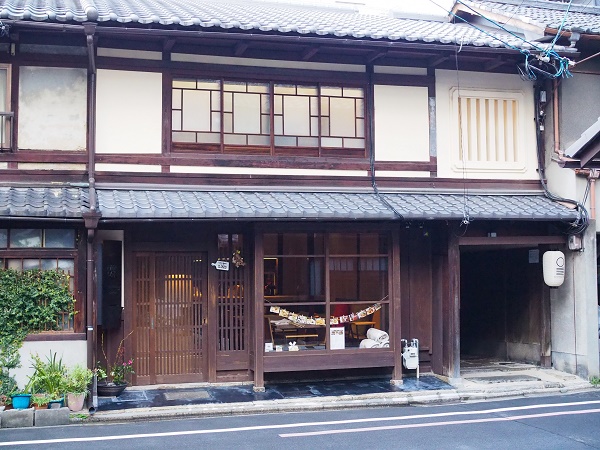
|
After a passage, an emotional encounter
The characteristic of Momiji-no-komichi is a large courtyard with a beautiful Japanese maple tree which is shared by several Kyo-machiya. Since it is shared, it becomes very important how to set rules and to form the relationships among tenants.
After the alleys one will find a marvelous space of Momiji-no-komichi which he/she could never expected before entering from the outside street. This is why any visitor makes a comment on his/her surprise and admiration each time. Visitors love this space, not only because of such a large courtyard, but also because of its atmosphere: the fusion of the freshness which one could sense from the renovated Kyo-machiya and the ancientness which one could find in the traditional methods of construction and the earthen walls. Mr. Wallin says, “we are here to offer a moment when people can experience such admirations.”
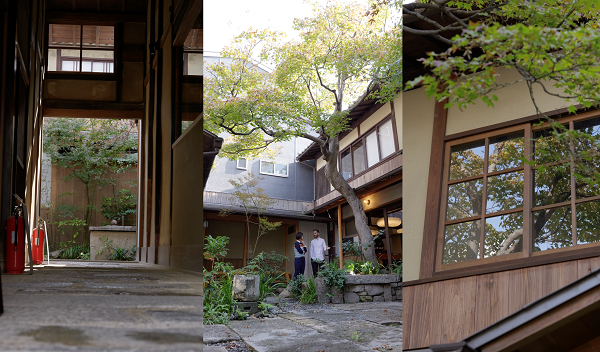
|
Shape Kyotointo the place where one wishes to revisit
We live in the modern times when similar types of buildings could be constructed at any place in any country. However, Kyo-machiya is the architecture found only in Kyoto. If we lose Kyo-machiya, we will lose one of Kyoto’s important culture. Mr. Wallin talks about the risk on this as follows:
“For most of the tourists visiting Kyoto, their main purpose is usually to make a tour of popular sightseeing spots such as Kiyomizu-dera Temple. However, if we would like to let those tourists “wish to come back to Kyoto agin,” the twonscape needs to be the one about which the visitors could remember such as “a nice and pleasant alley with a cozy shop.” For Japanese as well as for non-Japanese, any memory or impression kept after their visits to Kyoto are related to their emotional discoveries made during their explorations. If this townscape is lost, such discoveries will be lost, which might stop those visitors’ “wishing to come back to Kyoto again.” I strongly desire to conserve Kyo-machiya in order to avoid Kyoto’s becoming a tourist spot where people wish to visit once but not twice.”
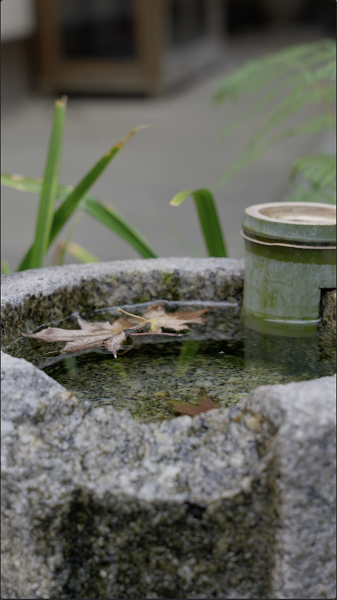
|
A marvelous building with flexibility
Mr. Wallin actually utilized Kyo-machiya as a multiple-use house, where the part on the ground floor was used as a shop and that on the 2nd floor as a house. He confirmed that there he could experience both easy-living and easy-working.
Mr. Wallin says, “With the case of any overseas house, I consider that “dual usage of a house” might be difficult in terms of zoning. With the case of Kyo-machiya where the “Next Use”is possible, it might be the most suitable building for those who wish to hold a start-up business or to work from home. Even if it is a row-house or an individual house, Kyo-machiya is the building which flexibly accommodates the needs of the users. For example, it is suitable as an atelier to create something or as a work place with any personal computers. The use of the Kyo-machiya building could be diversified and developed with various renovations. It is the merit of Kyo-machiya.”
Finally he added, “Limit is your imagination. (Whatever you imagine, you could realize it. It totally depends on your imagination.)”
Our interview with Mr. Wallin was filled with the attractiveness and fascinations of Kyo-machiya, since he himself had made a profound research on Kyo-machiya and also utilized and experience it.
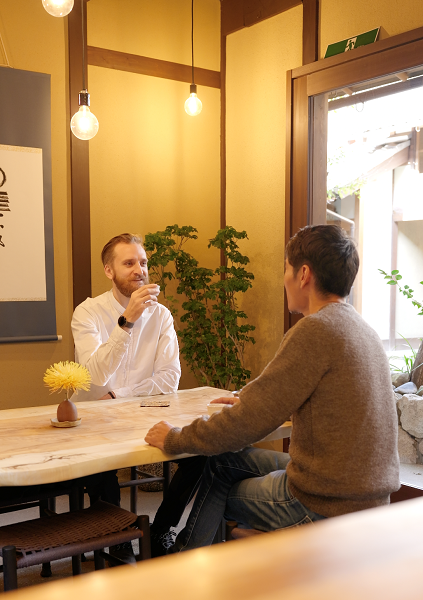
|

